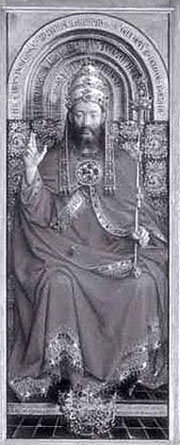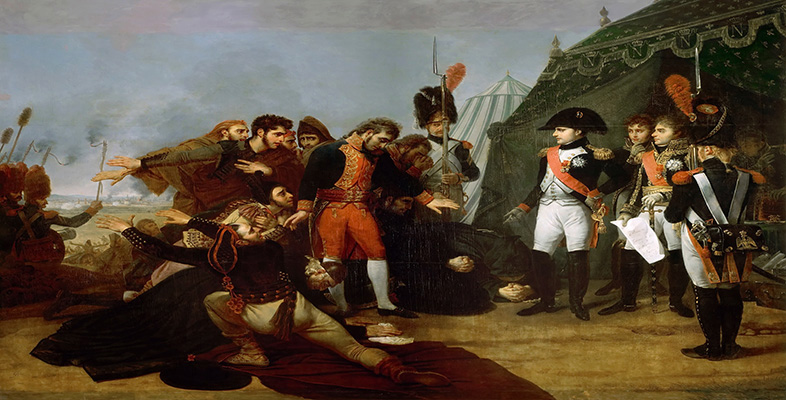2.7 Legitimating the regime
The failure of Ingres's painting is revealing of the problems of political legitimation faced by the regime. If it was difficult to justify the authority of a ruler who had seized power, it was even harder to justify a monarchy based on usurpation (the authority Napoleon had usurped being either that of the Bourbon dynasty from a royalist point of view or that of the people from a republican one). Ingres's image of timeless, otherworldly majesty can thus be seen as compensating, or rather trying to compensate, for the all too recent and highly dubious origins of Napoleon's imperial rule. Its failure was not simply a matter of bad timing but, on a deeper level, bound up with the opportunistic, improvisatory response to the problem on the part of the regime, which seized at any and every identity (Charlemagne, Brutus, etc.) that could serve a propaganda purpose and cast them aside as soon as they lost their relevance and usefulness. Furthermore, while it was not bothered about the overall consistency and coherence of its propaganda, the need to appeal to different shades of political opinion meant that the image of the emperor would ideally balance contradictory elements, reconciling sacred and secular, monarchical and revolutionary, traditional and modern, irrational and rational. The problem with Ingres's painting was that it focused exclusively on one side of the equation; the same can be said of David's Napoleon in his Study of 1812 (see Plate 15 [Tip: hold Ctrl and click a link to open it in a new tab. (Hide tip)] ), which otherwise could hardly offer a more different image of Napoleon.
Click to see plate 15 Jacques-Louis David, The Emperor Napoleon in his Study at the Tuileries, 1812, oil on canvas, Private Collection. Photo: Bridgeman Art Library

Exercise
Which of the previous portraits we have looked at does Napoleon in his Study most closely resemble, and in what ways does it depart from this model? What kinds of claims does David make here on Napoleon's behalf, and how do they differ from those made by Ingres's portrait of Napoleon enthroned?
Note: the word ‘Code’ that appears on the document on the desk indicates that it is a copy of the Civil Code or Code Napoleon of 1804.
Discussion
This painting returns to the iconography (the study of the meanings of images;) of Napoleon as First Consul, showing him standing in an interior in close proximity to official papers. More precisely, the portrait refers back to the period of the consulate, during which the Civil Code was drawn up, though it shows him stout and balding as he would have appeared in 1812. If anything, the image is more sober and businesslike than Gros's 1802 portrait, since Napoleon is wearing a relatively plain military uniform rather than an opulent ceremonial one. Also, since the papers are lying not on a table but on a desk at which he has evidently been working, there is an even stronger emphasis on his executive role. The clock giving the time as 4.15 and the guttering candles indicate that he has been working through the night. Another contrast with the consular portrait is that Napoleon is looking out at the viewer; this, combined with the fact that he is standing in close proximity to us rather than staring down from a great height, makes him seem more human and accessible to the viewer who, as we saw earlier, can be identified with the French people (see above). Thus, instead of an all-powerful and unapproachable monarch ruling by divine right, such as Ingres depicted, here we have the ruler as enlightened bureaucrat who labours on behalf of ‘us’, his people.
Like Ingres's painting, David's portrait of Napoleon in his study does not simply offer a certain image of the emperor but is bound up with a broader crisis of political legitimation. It acknowledges that, without a sacred basis for its authority, power has to keep working to justify itself. A ruler who lacks divine right is judged on his performance. In this respect, the problems faced by Napoleon were only an extreme version of those that the Enlightenment critique of established authority posed for more venerable monarchies. They, too, now needed to justify themselves in rational, utilitarian terms, on the basis of the benefits they brought their subjects. It is also important to note that Napoleon in his Study was another unofficial portrait, having been commissioned by a Scottish admirer, Alexander Douglas, the future Duke of Hamilton. Just as Ingres overcompensated for the instability of the regime, so David's modern, rational and functional image went too far in the opposite direction to be effective as imperial propaganda. Despite presenting an entirely positive vision of Napoleon (not least in showing him conscientiously labouring on the Civil Code by himself, when in fact his contribution largely took the form of chairing a legislative committee), it lacked the mystique and glamour needed to capture the popular imagination. Its sobriety stands in marked contrast to the propaganda images of the emperor commissioned by the imperial administration.
Exercise
You should now watch Women and Portraiture in Napoleonic Europe, referring first to the AV Notes.
Click to see the AV notes for the video clip
Click below to view part 1 of Women and Portraiture in Napoleonic Europe.
Transcript: Part 1
Click below to view part 2 of Women and Portraiture in Napoleonic Europe.
Transcript: Part 2
Click below to view part 3 of Women and Portraiture in Napoleonic Europe.
